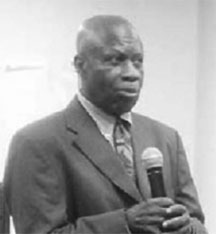A curriculum for a local mining school which will, among other things, help train miners in the use of alternatives to mercury in the gold recovery process is expected to be created within one year, World Wildlife Fund (WWF) Country Manager Dr Patrick Williams told Stabroek Business in a telephone interview on Tuesday.
Speaking with this newspaper shortly after the presentation by the WWF of a $12 million contribution to the Ministry of Natural Resources and the Environment to support a local programme aimed at phasing out the use of mercury in the mining sector, Dr Williams said the funding arrangement was “for one year” and that it was expected that within that time frame the curriculum for the mining school would be created.
Responding to a comment by Natural Resources and the Environment Minister Robert Persaud that mercury could be in use in the local gold industry for another ten years, Williams said the phasing out mercury was a process that was likely to take “some time”.

Manager Dr Patrick Williams
He said he was aware that the Government of Guyana had been in discourses with officials of the United Nations Environment Programme (UNEP) and other agencies concerned with the preservation of the environment and that there was an understanding that Guyana would be allowed a time frame within which to end mercury use in the gold mining sector. “There is an understanding that gold is important to the Guyana economy and that the withdrawal of mercury from the sector will have to be a phased one. In addition to that there will also be the requirement of time for the application of field tests for any new methods that may be applied in the industry,” Williams said. He said that the WWF was satisfied with evidence that was being made at the level of the GGMC to create a mining regimen that would exclude the use of mercury. “The WWF would like to see the creation of more sustainable approaches to gold mining in Guyana,” Williams added
A staunch lobbyist for the removal of mercury from the gold sector the WWF (Guianas) in April called for a public education programme that would sensitise local gold jewellers to health-related mercury issues.
Additionally, the WWF says it wants the Guyana Geology and Mines Commission (GGMC) and local safety and health authorities to monitor gold jewellery establishments to ensure they are equipped with protective equipment and first aid kits. The WWF’s recommendations were reportedly based on the outcome of a study on the application of mercury in the industry undertaken by the University of Guyana’s School of Earth Sciences.
A delegation from Guyana headed by Persaud and including representatives of the Guyana Gold and Diamond Miners Association (GGDMA) reportedly mounted a strident lobby during the three-day UNEP review conference in Bogota, which ended earlier this week, for a grace period prior to being required to comply with restrictions on the use of mercury in the gold recovery process.
While up to an estimated 15 million miners around the world are reportedly exposed to dangerous levels of mercury the Guyana delegation in Bogota reportedly advanced the argument that up to 100,000 local people depend on the gold mining sector for a living.





